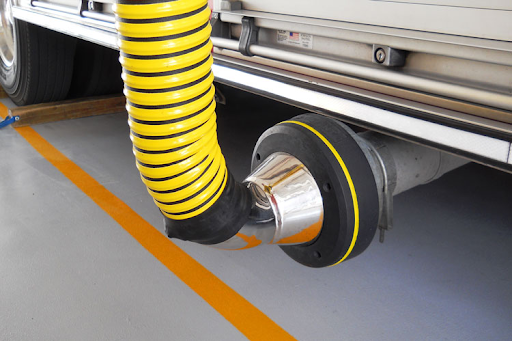A vehicle exhaust removal system is a critical part of maintaining air quality and safety in spaces where vehicles are operated, such as garages, workshops, and service centers. These systems are designed to capture and eliminate harmful emissions produced by vehicles, ensuring a safer, cleaner environment for workers and customers alike. In this guide, we will explore the features, functions, and benefits of a vehicle exhaust removal system, shedding light on why it is an essential investment for any business handling vehicles.
What is a Vehicle Exhaust Removal System?
A vehicle exhaust removal system is engineered to safely capture and remove harmful exhaust fumes, such as carbon monoxide, from an enclosed area. Typically, this system includes ducts, hoses, fans, and filters that work together to direct the exhaust emissions outside, preventing the dangerous accumulation of gases in the workspace. These systems are commonly used in automotive repair shops, fire stations, maintenance depots, and other facilities where vehicles frequently idle or are serviced.
Key Features of Vehicle Exhaust Removal Systems
- Flexible Hoses and Ducts: The core of most vehicle exhaust removal systems is the hose or ductwork, which is designed to connect directly to the vehicle’s exhaust pipe. These hoses are typically flexible, allowing them to reach vehicles at different positions, including undercarriages, while also being durable enough to withstand high temperatures.
- Automatic Activation: Many modern vehicle exhaust removal systems feature automatic activation. This means the system starts as soon as the vehicle is started or when the exhaust gases are detected. This ensures that harmful emissions are immediately removed without requiring manual intervention, providing greater efficiency and safety.
- Powerful Ventilation: The system uses high-power fans or blowers to pull the exhaust fumes from the vehicle and expel them outside, ensuring the workspace remains free of contaminants. Some systems feature variable speed controls to adjust airflow based on the volume of exhaust being produced.
- Sensors and Controls: Advanced vehicle exhaust removal systems often come equipped with sensors that detect exhaust levels and adjust system performance accordingly. These systems can automatically switch on or off, making them energy-efficient and responsive to changing conditions in the workspace.
- Filters and Scrubbers: To ensure that exhaust gases are effectively removed, some systems integrate filters or scrubbers. These elements help capture fine particulate matter and pollutants, reducing the impact on both air quality and the environment.
Functions of a Vehicle Exhaust Removal System
The primary function of a vehicle exhaust removal system is to capture and eliminate harmful exhaust emissions produced by vehicles. These emissions, which include carbon monoxide, nitrogen oxides, and particulate matter, can pose serious health risks if inhaled over prolonged periods. By removing these gases, the system helps create a safe and breathable environment for workers.
Additionally, the system improves indoor air quality by minimizing the buildup of fumes, making workspaces more comfortable and productive. For automotive service centers, this is particularly important, as workers may spend long hours in areas with high vehicle activity.
Furthermore, vehicle exhaust removal systems can be designed to handle high volumes of exhaust, making them suitable for larger facilities or environments with heavy vehicle traffic. The efficient removal of emissions ensures compliance with environmental and occupational health and safety regulations.
Benefits of Vehicle Exhaust Removal Systems
- Health and Safety: The most significant benefit of a vehicle exhaust removal system is improved health and safety for employees. By removing toxic fumes such as carbon monoxide, the system reduces the risk of poisoning, respiratory issues, and other health problems. Workers are less likely to be exposed to hazardous gases, ensuring a safer working environment.
- Compliance with Regulations: Occupational safety regulations and environmental laws require businesses to manage indoor air quality and limit exposure to dangerous gases. A vehicle exhaust removal system helps businesses comply with these regulations, avoiding fines and ensuring that they meet industry standards for workplace safety.
- Enhanced Productivity: A clean, well-ventilated workspace leads to a more comfortable environment, which in turn boosts productivity. Workers are less likely to feel fatigued or distracted due to exposure to exhaust fumes, and the system helps maintain proper ventilation levels even during peak vehicle activity.
- Environmental Impact: By efficiently removing harmful emissions and directing them outside, these systems contribute to reducing the overall environmental footprint of vehicle operations. This helps businesses demonstrate their commitment to sustainability and can enhance their reputation within the community.
- Long-Term Cost Savings: While the initial investment in a vehicle exhaust removal system may seem significant, it can lead to long-term savings. Reduced health care costs, improved worker efficiency, and compliance with safety standards can offset the initial costs over time, making the system a wise financial choice for many businesses.
Conclusion
A vehicle exhaust removal system is an indispensable tool for maintaining air quality and ensuring the safety and well-being of workers in automotive and other vehicle-dependent industries. Its features, functions, and numerous benefits make it a valuable investment for any facility handling vehicle emissions. By improving workplace safety, supporting regulatory compliance, and enhancing overall operational efficiency, these systems play a vital role in the modern workplace. Investing in a high-quality vehicle exhaust removal system is an essential step in creating a safer, healthier, and more productive work environment.
